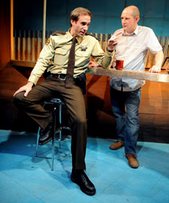HOME PAGE
SITE GUIDE
SEARCH
REVIEWS
REVIEW ARCHIVES
ADVERTISING AT CURTAINUP
FEATURES
NEWS
Etcetera and
Short Term Listings
LISTINGS
Broadway
Off-Broadway
NYC Restaurants
BOOKS and CDs
OTHER PLACES
Berkshires
London
California
New Jersey
DC
Philadelphia
Elsewhere
QUOTES
TKTS
PLAYWRIGHTS' ALBUMS
LETTERS TO EDITOR
FILM
LINKS
MISCELLANEOUS
Free Updates
Masthead
Writing for Us
A CurtainUp  London Review
London Review
 London Review
London Review2,000 Feet Away
|
If there was no river or water or whatnot. That piper would just have to keep walking and keep playing his pipe and the rats would keep following him. . . He'd be bound to those rats forever. Playing his pipe and leading those rats... in perpetuity— Deputy
|

Joseph Fiennes as Deputy Moss and Ian Hart as A.G.
(Photo: Tristram Kenton) |
2,000 Feet Away is set in Eldon, Iowa, the inspiration of Grant Wood's painting American Gothic and where, at the Gothic Festival each year, its residents dress up as the portrait's characters and stand in front of the famous house. A new law forbids sex offenders to live within 2,000 feet of anywhere children might congregate, including schools, shopping malls and bus stops. The Deputy (Joseph Fiennes) has to serve eviction notices to his neighbours, even in the midst of his uninterrupted consumption of pancakes and syrup. It soon becomes clear that there is nowhere left for these men who have been removed and dumped now the community has washed its hands of them.
Lucy Osborne's set design simultaneously suggests an endless desert of landscape and the claustrophobia of small town America. Strips of corrugated iron lit by a warm, red glow are seen through a wide panoramic window within the tiny auditorium. The stage is populated by an angled metal table and counter with streaks of rust, while a highway motel sign, representing the last, out-of-town refuge of the sex offenders, is at one end of the stage and a copy of Wood's painting at the other.
Within a skilled, convincing ensemble, Joseph Fiennes is predictably excellent as the affable Deputy charged with enforcing the new law. Playing with the stereotype of dumb, doughnut-eating police officer, his geniality is caught between the fearful vehemence unleashed against the sex offenders and the evicted criminals themselves who he must herd into remoteness. A slight caveat is that Fiennes is too handsome (not to mention slim) to be a permanent bachelor with weight sensitivity issues. Ian Hart is also impressive as A.G, one of the evictees, with his liminal face and sympathetic performance, full of sadness and desperation.
Anthony Weigh's writing is structurally accomplished with short, cinematic-style scenes, ring composition and a shifting focus on the protagonists. The themes the play engages with are fascinating, relevant and with the potential to be considered inflammatorily controversial. Children are not primarily portrayed as victims, but taunting precocious bullies. The villainy comes not from the sex offenders, but a society that endorses a reactive, superficial law which only addresses the symptoms and not the cause of the problem. Religion offers no solution but mindless fire and brimstone talk simply fuels the fear and intolerance.
Also, the play employs two running paradigms: the Pied Piper and the American Gothic painting. Whilst one is a story of unpalatable exiles and selfish mercenary townsfolk, the other indicates the exploration of American identity. Although culturally feted, the painting suggests something primitive and backward about Eldon, a grimly puritanical slice of rural America. Moreover, guarding the property with pitchfork, the couple depicted are a human Keep Out sign.
In a fine production with first-rate acting, this is a non-prescriptive, intelligent play which looks at the root of controversial dialectics. With a full house every performance and a sizeable cast, this play is almost too large for the Bush Theatre, so we can only hope for a West End transfer.
|
2,000 Feet Away
Written by Anthony Weigh Directed by Josie Rourke With: Joseph Fiennes, Ian Hart, Roger Sloman, Phyllis Logan, Kirsty Bushell, Kevin Trainor, Joe Ashman, Oliver Coopersmith, Miranda Princi, Charlotte Beaumont Design: Lucy Osborne Lighting: James Farncombe Sound: Emma Laxton Running time: 1 hour 30 minutes with no interval Box Office: 020 7610 4224 Booking to 12 th July 2008 Reviewed by Charlotte Loveridge based on 16th June 2008 performance at The Bush Theatre, Shepherds Bush Green, London, W12 8QD (Tube: Shepherd's Bush) |
|
REVIEW FEEDBACK Highlight one of the responses below and click "copy" or"CTRL+C"
Paste the highlighted text into the subject line (CTRL+ V): Feel free to add detailed comments in the body of the email and state if you'd like your comments published in our letters section. |
|
London Theatre Tickets Lion King Tickets Billy Elliot Tickets Mighty Boosh Tickets Mamma Mia Tickets We Will Rock You Tickets Theatre Tickets |




